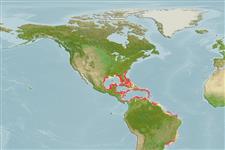Klassifizierung / Names
Namen | Synonyme | Catalog of Fishes (gen., sp.) | ITIS | CoL | WoRMS | Cloffa
Actinopterygii (Strahlenflosser) >
Perciformes (Perch-likes) >
Serranidae (Sea basses: groupers and fairy basslets) > Epinephelinae
Etymology: Mycteroperca: Greek, mykter, -eros = nose + Greek, perke = perch (Ref. 45335).
Lebensraum / Klimazone / Range
Ökologie
; seewasser riff-verbunden; tiefenbereich 2 - 150 m (Ref. 5222), usually 2 - 35 m (Ref. 40849). Subtropical, preferred ?; 33°N - 26°S, 98°W - 38°W (Ref. 5222)
Western Atlantic: Gulf of Mexico, Bermuda, Caribbean (mainly insular localities), and Brazil.
Size / Gewicht / Alter
Maturity: Lm ? range ? - ? cm
Max length : 84.0 cm TL Männchen/unbestimmt; (Ref. 40637); common length : 40.0 cm TL Männchen/unbestimmt; (Ref. 5217); max. veröff. Gewicht: 10.2 kg (Ref. 40637); max. veröff. Alter: 41 Jahre (Ref. 36872)
Rückenflossenstacheln (insgesamt): 11; Rückenflossenweichstrahlen (insgesamt): 16-18; Afterflossenstacheln 3; Afterflossenweichstrahlen: 10 - 12. Distinguished by the following characteristics: Tan to brown above, paler below; upper parts of head and most of body usually have small, brown, close-set spots; sometimes uniformly brown. Adults have exerted rays that are even and about equal in length; 23-27 total gill rakers (Ref. 26938); depth of body 3.0-3.4 times in SL; head length 2.8-3.0 times in SL; angular preopercle, enlarged serrae on prominent lobe at the angle and a distinct notch above the serrate lobe; greatly enlarged posterior nostrils in adults (Ref. 89707).
Found mainly on rocky or coral bottoms from the shoreline to at least 55 m depth; small and middle-sized individuals commonly occur in mangrove-lined lagoons. Feeds on fishes. Sex-reversal observed (Ref. 5521). More common in island waters than along the coast (Ref. 26938). The tricolored pattern of the juveniles mimics that of the juveniles of the clown wrasse, Halichoeres maculipinna. The aggressive mimic’s behavior includes folding down the median and caudal fins, which adds to its wrasse imitation and allows it to approach its otherwise wary prey (Ref. 43465). Marketed fresh; flesh is of good quality.
Life cycle and mating behavior
Geschlechtsreife | Fortpflanzung | Ablaichen | Eier | Fecundity | Larven
Pelagic spawner (Ref. 32199).
Heemstra, P.C. and J.E. Randall, 1993. FAO Species Catalogue. Vol. 16. Groupers of the world (family Serranidae, subfamily Epinephelinae). An annotated and illustrated catalogue of the grouper, rockcod, hind, coral grouper and lyretail species known to date. Rome: FAO. FAO Fish. Synop. 125(16):382 p. (Ref. 5222)
IUCN Rote Liste Status (Ref. 115185)
CITES (Ref. 94142)
Not Evaluated
Bedrohung für Menschen
Harmless
Nutzung durch Menschen
Fischereien: kommerziell; Aquarium: Öffentliche Aquarien
Mehr Information
PartnerBilderStamps, CoinsLauteCiguateraGeschwindigkeitSchwimmstilKiemenoberflächeOtolithsGehirngrößeSehfähigkeit
Tools
Zusatzinformationen
Download XML
Internet Quellen
